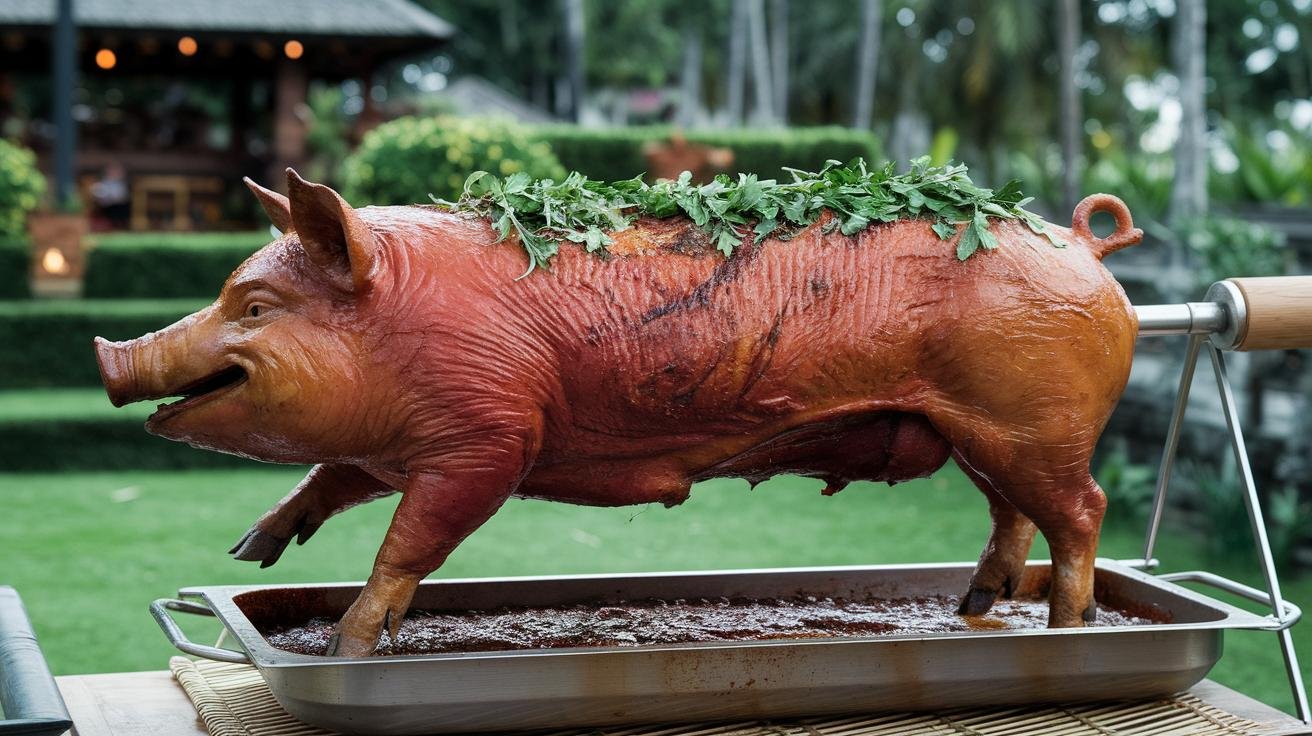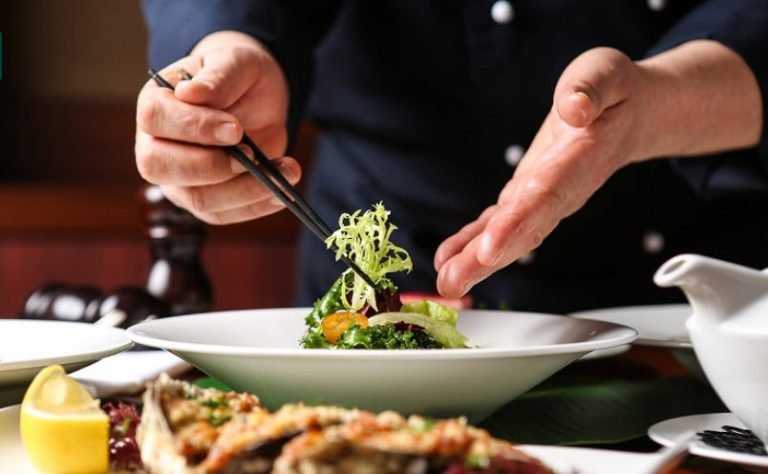What is Babi Guling: Balinese Spit Roast Explained
Ever thought your holiday roast couldn’t top a turkey? Bali would beg to differ. Picture babi guling (whole pig slow-roasted until the skin crackles like golden sugar). Pure bliss.
This dish began as a temple offering to celebrate abundance. Now it’s a warm invitation to taste centuries of tradition in every spice-kissed bite. Oops, I mean… every mouthful.
Imagine crisp crackling under your fork and the gentle warmth of turmeric dancing on your tongue. You’ll feel like you’re at a festival beneath swaying palm leaves. Tempted yet?
What Is Babi Guling: Balinese Spit Roast Explained
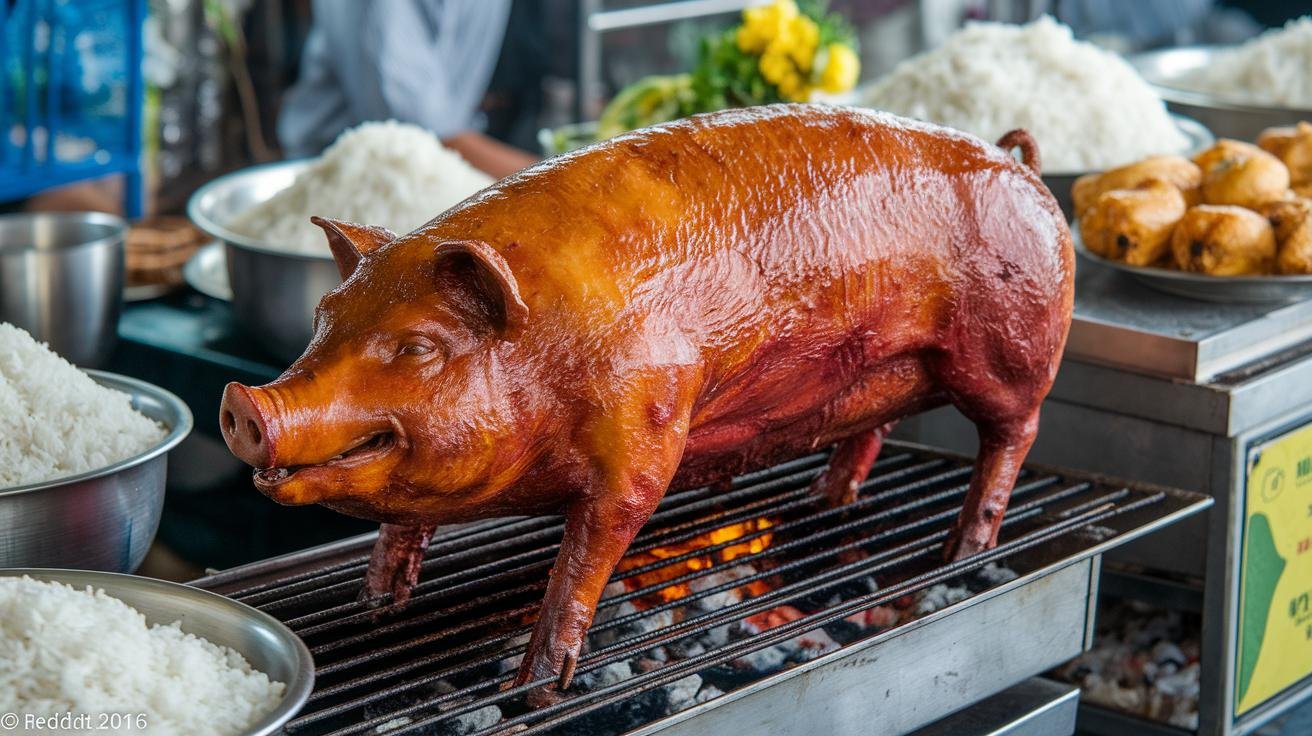
Babi guling whispers Bali’s warm hospitality. It’s a whole pig slow-roasted until the skin cracks like golden sugar. Back when it was first made, families offered it at temple ceremonies as a sign of abundance, and that sense of celebration still lingers. Ever pictured slicing into juicy pork beneath swaying palm fronds?
Here’s how it unfolds. The pig gets a fragrant spice paste rubbed inside and out, turmeric, lemongrass, a hint of kaffir lime, and then it’s skewered on bamboo (or metal) above glowing coconut husks. It turns slowly, as we baste it with coconut oil, sealing in moisture and crisping the skin to a sweet crackle. Hours drift by while smoke and spice dance together. Tranquility.
Today you’ll spot babi guling at tiny roadside warungs (small eateries) and even at luxe villas. It’s served over fluffy steamed rice, with side dishes that make each bite a celebration:
- vegetable-lawar (shredded veggies mixed with grated coconut and spices)
- sambal matah (fresh shallot chili relish)
- pork-skin crackers
Pure bliss in every plate, a taste of Bali’s rich heritage you’ll want again and again.
Origins and Ceremonial Roots of Babi Guling in Bali
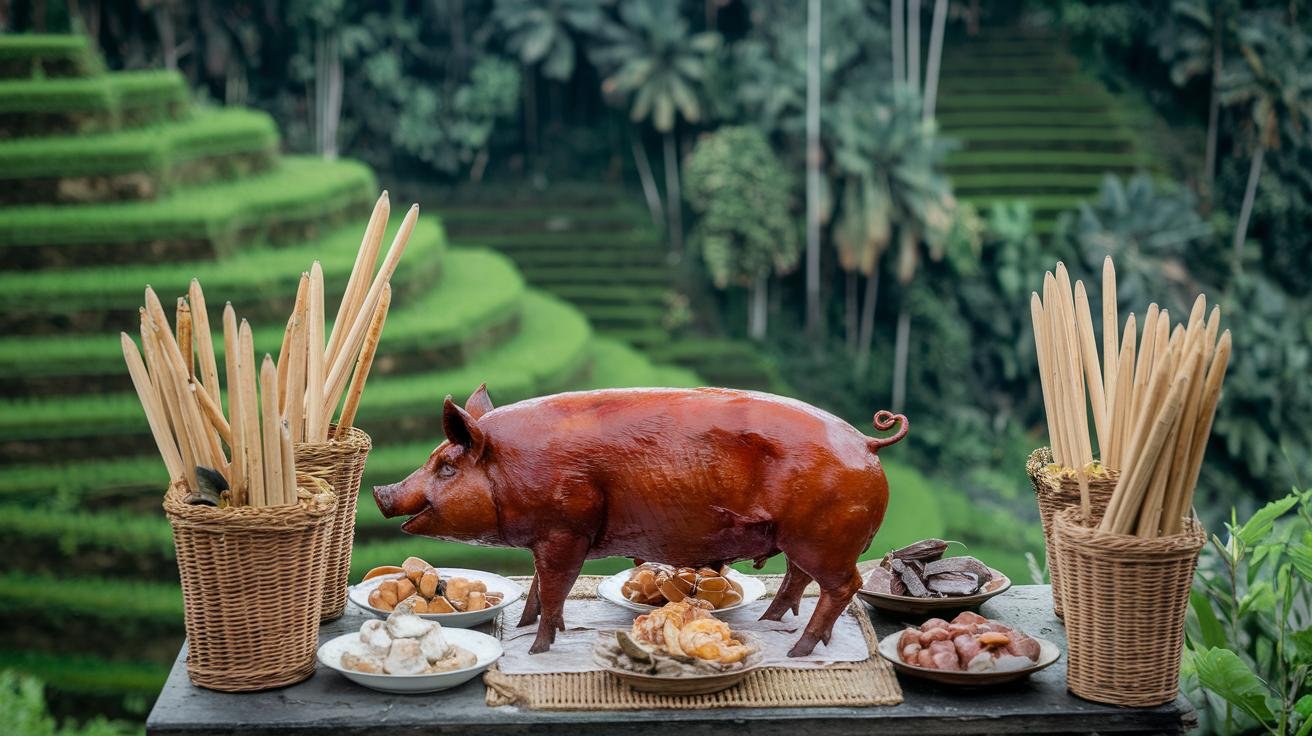
Long ago, palm‐leaf manuscripts (like old notebooks) dated around 200 BCE mention base genep (traditional spice mix) called “usabe.” Priests roasted whole pigs over bamboo spits that glowed amber, while coconut husks crackled below. The warm scent of turmeric and peppery galangal (a root in the ginger family) filled the courtyard. Families gathered, chanting softly, as the pig turned slowly – an offering of perfection and abundance.
Over the centuries, the taste of these ceremonies drifted beyond temple walls. By dawn, small warungs (roadside cafés) would light their bamboo spits to serve tender pork – just like they did at ancient feasts. Pure bliss. Before slicing in, they’d set aside a tiny Canang sari (flower offering) as a quiet nod to the gods.
Today, babi guling is woven into everyday life. You’ll find it under dim lanterns on buzzing streets or tucked beside rice terraces (stepped fields that glow emerald at sunrise). Each bite gives you crackling skin, fragrant meat, and a whisper of its sacred past.
By the way, local families still save it for temple anniversaries – keeping that sacred spark alive.
Bumbu Bali Spice Blend and Marination Techniques for Babi Guling
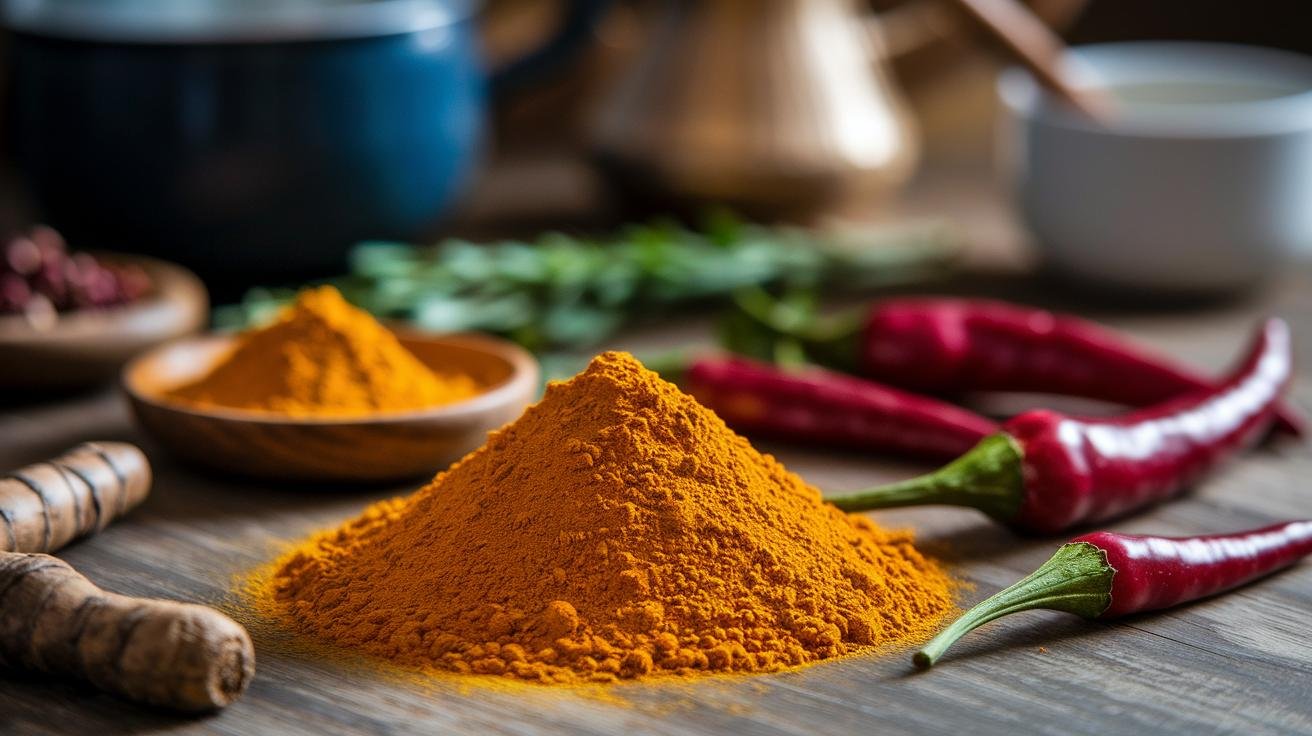
Ever dreamed of tasting the perfect babi guling (Balinese roast pig)? It all starts with bumbu Bali spices – the heart of every bite. You grind Indonesian bay leaves (daun salam), lemongrass (aromatic grass), galangal (a ginger-like root), ginger, red chilies, shallots, garlic, and candlenuts (tropical nuts that make the paste silky). Pure bliss.
Oops, let me rephrase that. You mix those aromatics into a creamy coconut-turmeric paste. Then coat your pig inside and out. Let it rest so the flavors sink deep.
Every so often, you baste with coconut milk or oil. That keeps the meat juicy. It also teases the skin to crackle. Tranquility.
Some warungs (local eateries) even add a spoonful of Thai shrimp paste. Um, it brings a gentle umami note.
Here’s the full spice lineup:
- Indonesian bay leaves (daun salam)
- lemongrass (aromatic grass)
- galangal (ginger-like root)
- ginger
- red chilies
- shallots
- garlic
- candlenuts (tropical nutshells)
- kaffir lime leaves
- turmeric
- long Javanese pepper
- sand ginger
- cumin
- coriander
- cloves
- nutmeg
This coconut-turmeric paste packed with bumbu Bali spices lifts your pig marination to new heights – earthy, warm, and irresistible.
Mastering the Open-Fire Spit Technique in Babi Guling Roasting
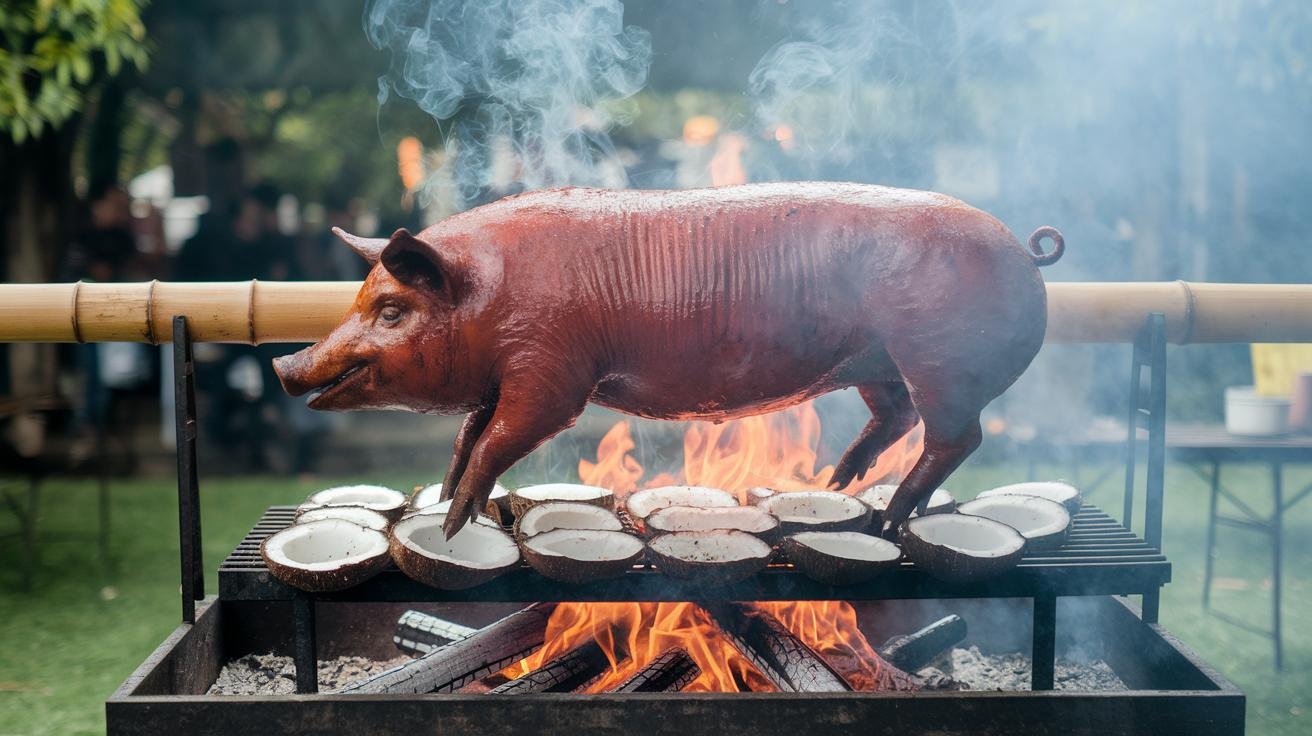
First, pick a spit that feels right for you. Bamboo spits are light and lend a gentle woodsy aroma (they do need careful handling though). Metal spits hold their shape over hot coals and wipe clean in seconds, super handy when you’re racing the sunset.
Next, build your fire on a bed of coconut husks (the rough outer shell of the coconut). They burn down to glowing embers with a hint of sweetness. Ever watched coals glow amber-red? Turn the spit at about one spin per minute, slow and steady like a calm dance, so every inch gets the same cozy heat.
To know when it’s cooking just right, watch the drips. Clear oil means keep it turning. When droplets run amber, you’re almost there. Around the 2-hour mark, start basting with silky coconut milk, oops, wait, let me rephrase that, use a thin coat of coconut milk every 30 minutes after that. You’ll get crisp, sweet layers that crackle under your knife.
When the roast looks golden and your senses are singing, pause. Let it rest for 15–20 minutes so the juices settle. Then carve each slice tender and juicy. Pure bliss.
Flavor Profile and Irresistible Crispy Skin Texture of Babi Guling
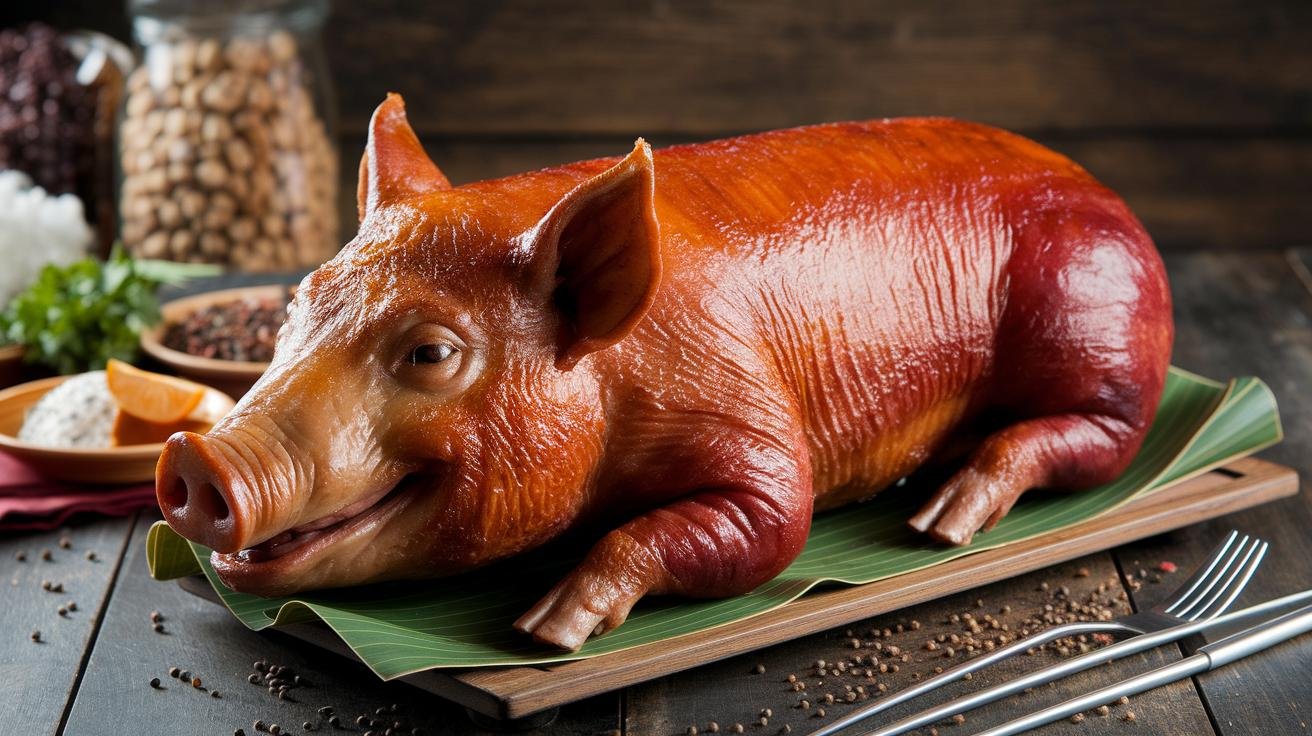
Imagine sinking your teeth into Babi Guling (Balinese spit-roasted pig) where sweet caramel notes dance with a gentle citrus tang and a whisper of chili. Ever tasted something that feels like a warm hug in every bite?
That crackle, oh that crackle. The skin shatters into crispy shards, revealing silky ribbons of fat that melt against tender, juicy pork. Oops, let me rephrase, it’s a tiny flavor fireworks show.
A kiss of smoky fragrance drifts over each slice, while a touch of caramelized sugar softens the savory depth. Next, the warm, nuanced spice blend wafts through the air, inviting you in.
Right here, the heady scent of aromatic spices hangs on the breeze, teasing your senses with a promise of island heritage in every mouthful.
Serving Traditions: Nasi Babi Guling with Accompaniments
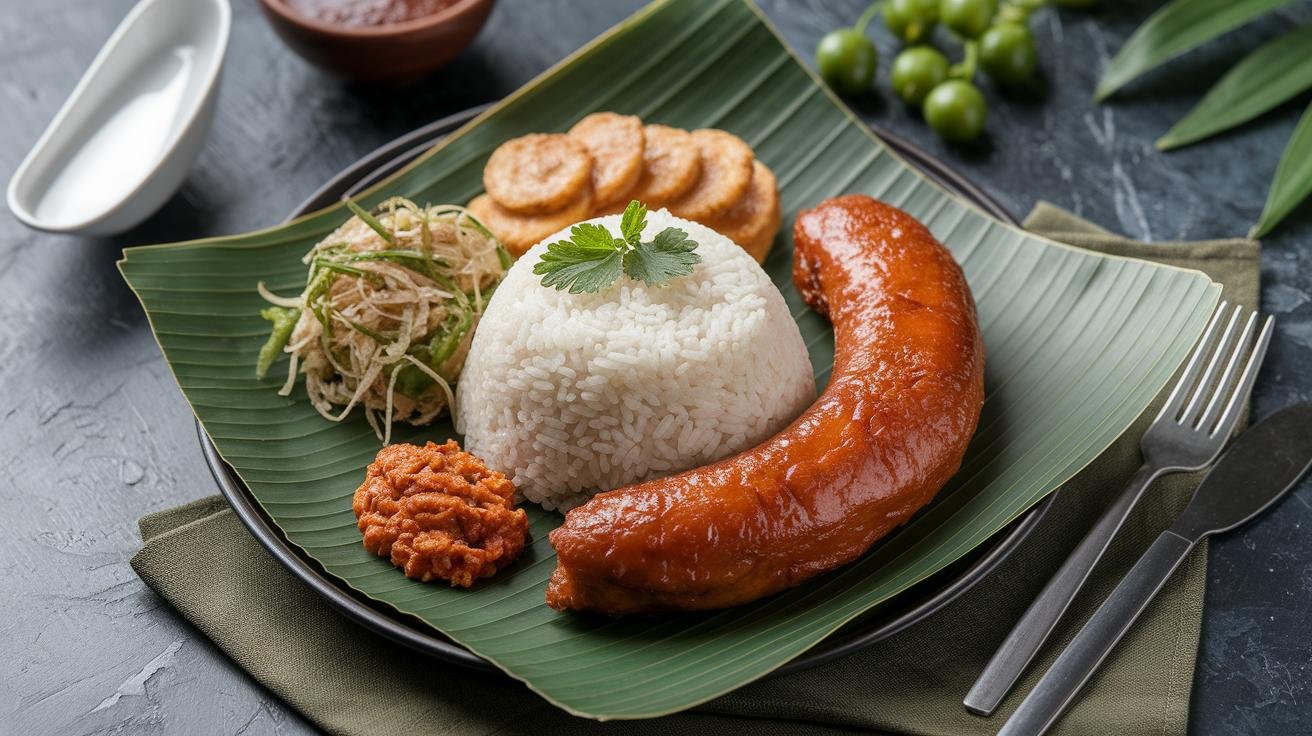
Imagine a mound of fluffy white rice resting on a fresh banana leaf (it adds a soft, grassy sweetness). The leaf keeps the plate cool and whispers a hint of tropical breeze to every bite.
Next, the classic sides make their entrance: lawar (shredded vegetables and coconut salad), urutan (spicy Balinese pork sausage), sambal matah (raw shallot and lemongrass chili sauce), and crispy pork-skin crackers. Savory, spicy, sweet, and crunchy, pure bliss on your spoon.
Ever noticed that gentle crackle under your fork? Those golden shards are the heart of every celebration.
By the way, there’s a sweet little ritual before the feast. Thin slices of ear, nose, tail, foot, and tongue go into a Canang Sari offering (a small palm-leaf basket with flowers). It’s a tender nod to the gods.
Then the rest of the pork is carved and passed around among friends and family. Tranquility. Joy. Community.
Regional Styles and Top Warung Recommendations for Babi Guling in Bali
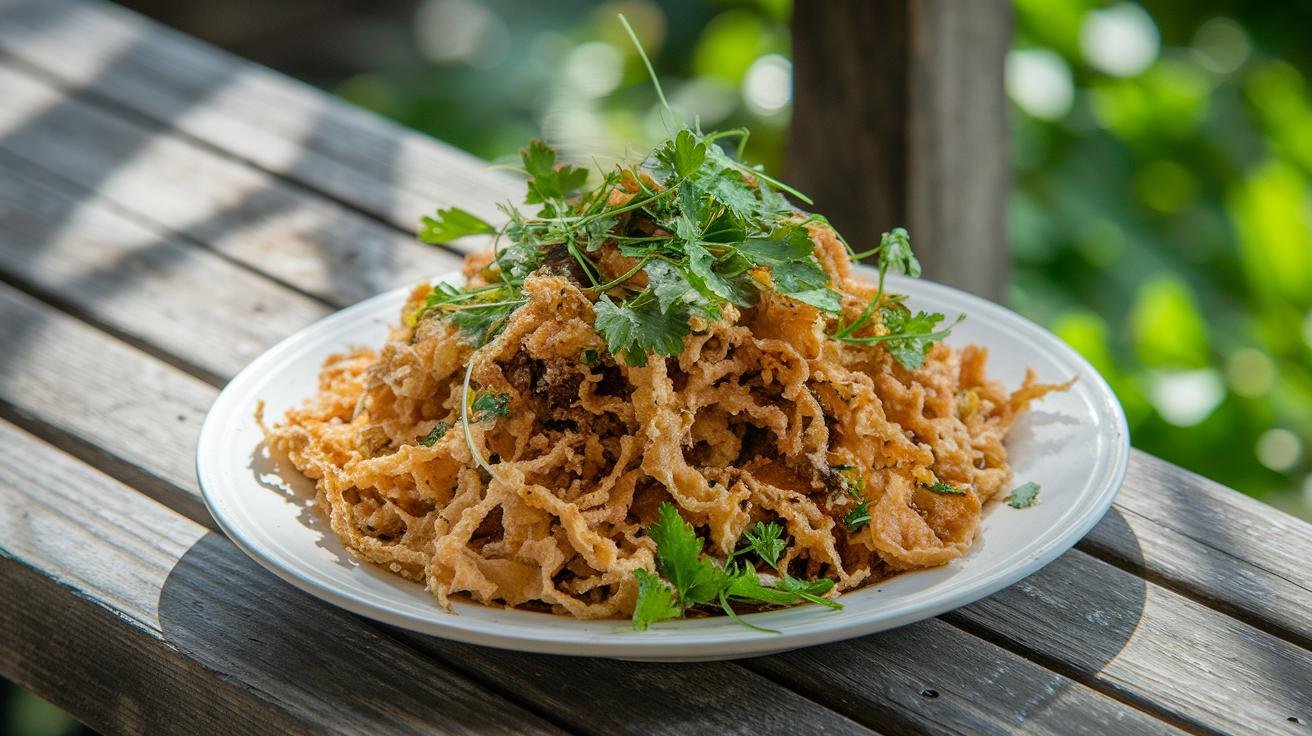
Ever dreamed of tasting babi guling (Balinese roast pork) at a little warung (open-air eatery) where locals line up? Ubud’s version has tender pork dripping with earthy chili and the soft murmur of bamboo leaves overhead. And in Sanur, you’ll find pork kissed by sea breeze and coastal spice. Pure bliss.
Our top four warungs are just steps from palm-lined paths.
Ibu Oka in Ubud roasts six pigs a day, expect crackling skin and juicy meat served on a cool banana leaf for IDR 30,000–80,000.
Pak Dobiel in Benoa is your midday hero, serving its Babi Guling Complete for two at IDR 80,000.
Bu Made Sekar in Kuta stays open late, so you can grab a warm rice bowl (nasi) with pork bits from IDR 35,000.
Sanur Warung in Sanur blends lemongrass and sea salt into its Nasi Babi Guling Spesial at IDR 40,000.
| Warung | Location | Specialty | Price |
|---|---|---|---|
| Ibu Oka | Ubud | Roasts up to six pigs daily | IDR 30,000–80,000 |
| Pak Dobiel | Benoa | Babi Guling Complete for two | IDR 80,000 |
| Bu Made Sekar | Kuta | Rice bowls | IDR 35,000+ |
| Sanur Warung | Sanur | Nasi Babi Guling Spesial | IDR 40,000 |
Next, if you want more hidden gems and Balinese flavors, see Balinese cultural foods to try in Ubud.
Babi Guling Recipe Variations and Home-Cooking Tips
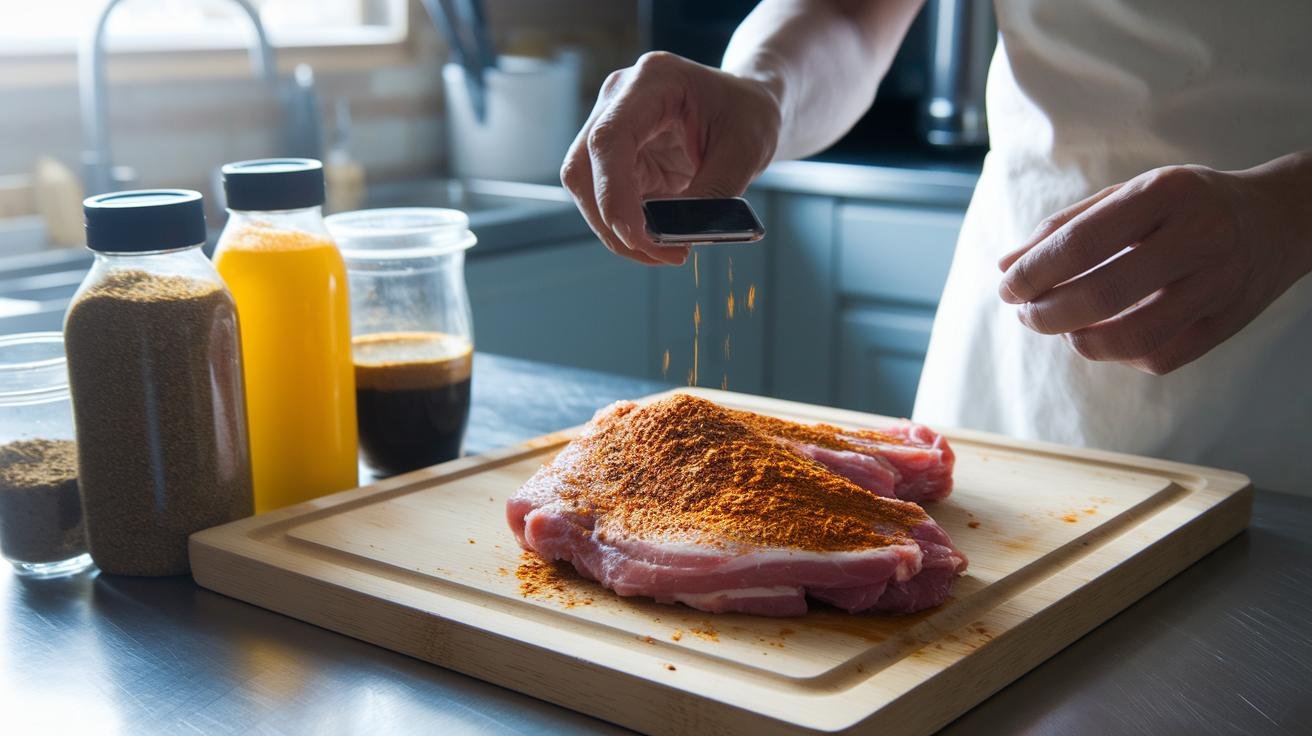
Imagine your backyard filled with the warm glow of charcoal or coconut husks (dried coconut shells) and the sweet, smoky scent drifting through the air. You’ll find a few simple tweaks can take your Babi Guling from great to unforgettable.
Try these friendly marinade swaps:
- Shrimp paste (fermented prawn paste) lightened up, use half the usual amount for a gentler umami.
- Nut-free twist? Stir in sunflower-seed paste instead of peanuts.
- In the final hour, brush on a palm sugar glaze for a golden, caramel finish.
- And don’t forget extra sambal matah (raw Balinese chili relish) on the side for a bright, tangy kick.
Plan on about 3–4 hours of slow cooking over charcoal or coconut husks. Oops, let me rephrase that, it’s ready when the thickest part of the roast reaches 160°F (71°C). Pure bliss.
Final Words
Diving straight in, we uncovered the essence of babi guling as a Balinese spit-roasted classic and traced its humble ceremonial roots through history. We saw how it became a must-try street-food staple across Bali.
Next, you explored the Bumbu Bali spice blend and mastered the open-fire spit method. Tasting tender pork under crisp crackling and checking out Nasi Babi Guling plating, warung favorites, and simple home tips.
Your craving for what is babi guling: Balinese spit roast explained finds its perfect ending here. Pure bliss awaits with every savory, spiced bite and island memory.
FAQ
What is babi guling and what does the name mean?
Babi guling is a traditional Balinese spit-roasted suckling pig. The name literally means “roasted pig” in Indonesian, highlighting a young pig slow-roasted with fragrant spice paste.
What is the significance of babi guling in Bali?
The significance of babi guling in Bali lies in its roots as a Hindu ceremonial offering symbolizing abundance and perfection. Today it bridges sacred tradition and daily life as a beloved local specialty.
What does babi guling taste like?
The taste of babi guling combines savory, spicy and slightly sweet notes with a crisp, crackling skin. Turmeric, lemongrass and chilies infuse the tender pork for rich Balinese flavor.
How do you make babi guling at home?
Making babi guling at home starts by rubbing a young pig with bumbu Bali spice paste, then slow-roasting it over charcoal or wood fire. Baste with coconut milk or oil for moist, crispy skin.
How does babi guling compare to lechon?
Babi guling differs from lechon by using a fragrant Balinese spice paste including turmeric, lemongrass and galangal plus coconut milk basting. Lechon relies on salt, pepper and local herbs for its flavor.
Where can I find the best babi guling in Bali?
Finding the best babi guling in Bali means visiting iconic warungs like Ibu Oka in Ubud or Pak Dobiel in Benoa. Seminyak and Sanur also serve top spots for tender, crispy roast pork.
How much does babi guling cost in Bali?
Babi guling in Bali typically costs between IDR 30,000 and 80,000 per serving at local warungs, depending on region and portion size.

